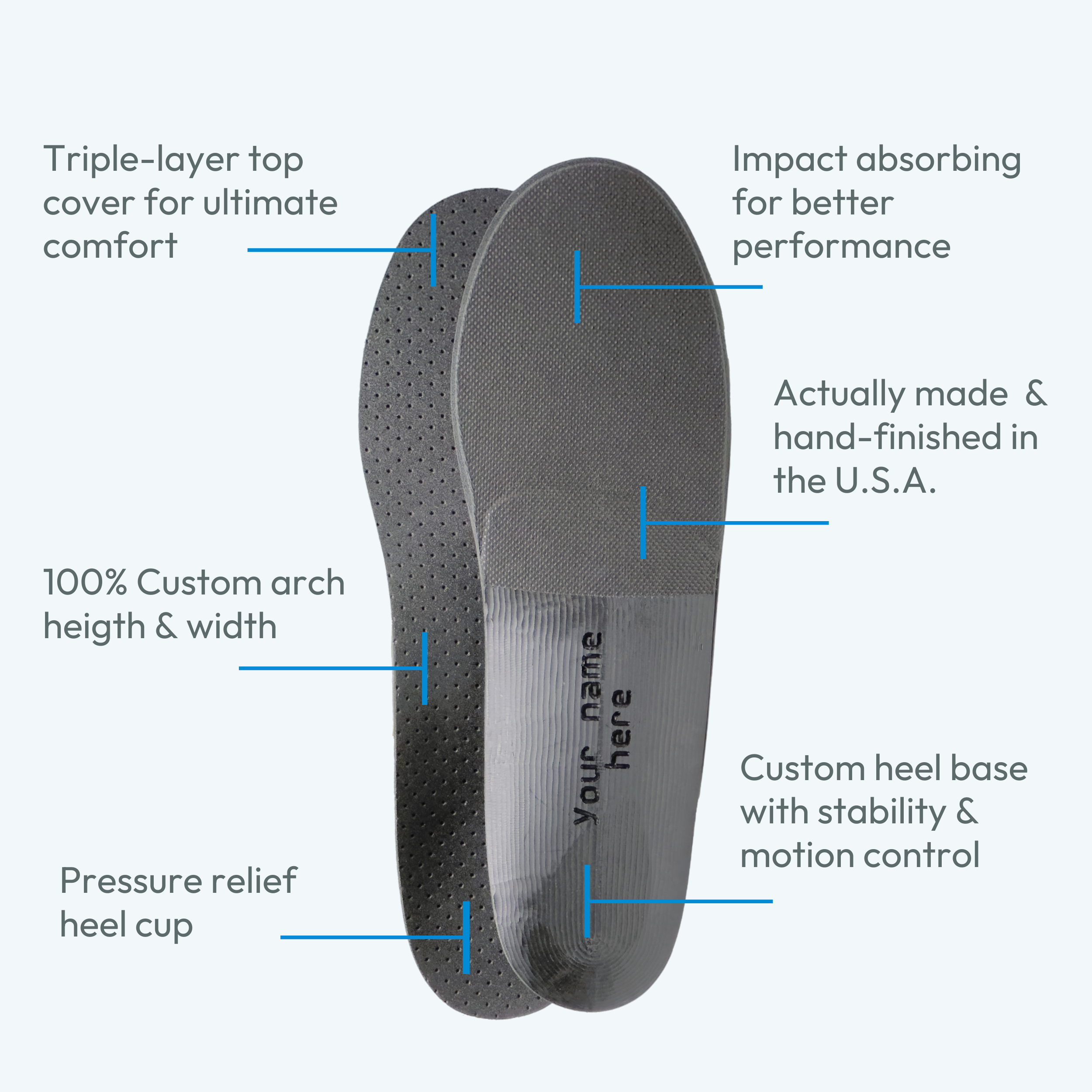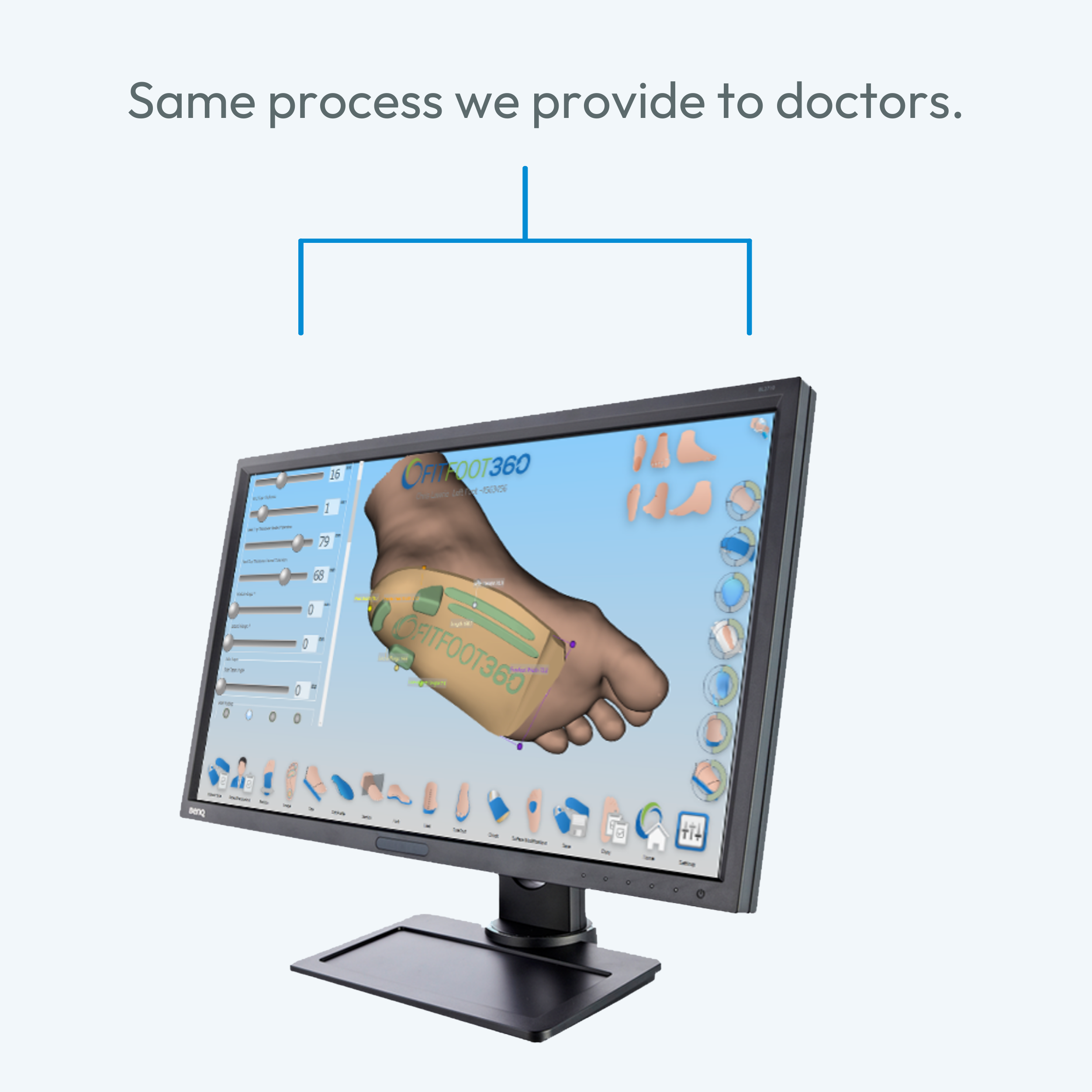Achilles Tendonitis: The Ultimate Guide to Causes, Symptoms, and Definitive Treatment
Created & written by Bilt Labs:
Do you feel a dull ache or stiffness in the back of your ankle, especially after exercise? If this pain worsens when you push off your foot, you likely suffer from Achilles Tendonitis. This common overuse injury involves inflammation and micro-tearing of the body’s largest tendon. Indeed, the problem often stems from poor foot mechanics, not just muscle tightness. Consequently, this comprehensive guide provides essential facts. It explains the core mechanical forces (torsion and excessive strain) that damage the tendon. Furthermore, it details how foot instability drives chronic inflammation. Ultimately, you will understand why Custom Orthotics made for Achilles Tendonitis (Read more about how custom orthotics treat Achilles Tendonitis) are the definitive medical solution for stabilizing the heel and eliminating damaging rotational stress. This expert analysis focuses on true biomechanical control.
Table of Contents
- 1. Anatomy of Achilles Tendonitis: The Cause of Torsional Strain
- 2. Specific Symptoms: Stiffness, Pain, and Location of Inflammation
- 3. Specific Symptoms: Overpronation, Tightness, and Activity Overload
- 4. How to Self-Diagnose and Palpate the Painful Area
- 5. Comparing Treatment Options: RICE, Stretching, and Orthotics
- 6. Why Custom Orthotics are the Definitive Stabilization Treatment
- 7. Verified User Experience
- 8. Conclusion and Ultimate Takeaway
- 9. Frequently Asked Questions About Achilles Tendonitis
1. Anatomy of Achilles Tendonitis: The Cause of Torsional Strain
The Achilles tendon connects the calf muscle (gastrocnemius and soleus) to the back of the heel bone (calcaneus). It is crucial for walking, running, and jumping. Tendonitis develops when the tendon is subjected to repetitive microtrauma. This results in chronic inflammation and subsequent breakdown (tendinosis). Indeed, this breakdown occurs due to two primary forces: excessive tension (strain) and twisting (torsion). The tendon is designed for linear pull. It is poorly suited for twisting forces.
The Mechanical Failure: Rotational Stress from Overpronation
The leading biomechanical cause is foot instability. When the foot rolls excessively inward (Overpronation) during gait, the heel bone (calcaneus) rotates. This rotation causes the attached Achilles tendon to twist or bow unnaturally. This torsional stress irritates the tendon fibers. It prevents them from gliding smoothly. Consequently, this leads to chronic inflammation, often several inches above the heel insertion. A deep, rigid heel cup is essential here. It mechanically controls the heel bone. This prevents the twisting force.
Link to Calf Tightness and Muscle Strain
A naturally tight calf muscle pulls constantly on the Achilles tendon. This is common in runners and athletes. However, tightness combined with biomechanical instability creates a dual problem. The rigid High Arches foot type, prone to Supination, also suffers. This rigidity sends powerful vertical shock forces up the leg. This sudden jarring stresses the already tight tendon. Regardless of the arch type, reducing tension and torsional strain is the key therapeutic goal.
2. Specific Symptoms: Stiffness, Pain, and Location of Inflammation
Achilles Tendonitis symptoms are highly localized. Recognizing the exact location helps determine the severity and type of injury.
Classic Morning Stiffness and Post-Activity Pain
The defining symptom is stiffness in the tendon. This is most pronounced first thing in the morning. Consequently, this stiffness often eases slightly with movement. However, the pain typically returns after intense exercise or long periods of standing. Palpating the tendon often reveals thickening or a noticeable bump. This is a sign of chronic inflammation and scar tissue formation (tendinosis). The pain intensifies when pushing off the toes, such as during running or climbing stairs.
Pain Location: Insertional vs. Non-Insertional
Tendonitis can be categorized by location.
- Non-Insertional: Pain and swelling occur in the middle section of the tendon. This is usually due to poor blood flow and severe rotational stress.
- Insertional: Pain occurs right where the tendon meets the heel bone. This is often associated with bone spurs and rotational strain transferred directly to the bony attachment.
Both types require reducing mechanical movement. They need stabilization of the heel bone. This is provided by rigid orthotic support.
3. Specific Symptoms: Overpronation, Tightness, and Activity Overload
Achilles Tendonitis is primarily a mechanically-driven condition. Its root cause lies in how the foot transmits force and stability.
Overpronation: The Primary Torsional Culprit
The excessive inward roll of the heel bone, characteristic of Overpronation, is the worst mechanical offender. As the arch collapses, the calcaneus tilts inward. This forces the tendon to twist like a corkscrew during walking. This persistent torsional stress prevents the tendon from healing. It causes the condition to become chronic. Furthermore, treating Achilles pain without controlling this heel rotation is often a failed treatment plan. The orthotic must lock the heel in place.
Co-Existing Conditions: Plantar Fasciitis and Heel Pain
Achilles Tendonitis often co-exists with Plantar Fasciitis. The calf muscle and Achilles tendon connect directly to the plantar fascia via the heel bone. Tightness in the calf increases the tension on the fascia. Consequently, excessive pronation (which drives both conditions) makes the entire posterior chain vulnerable. Addressing heel stabilization resolves both the rotational strain on the Achilles and the tensile strain on the fascia. Both are forms of Heel Pain.
Expertise & Authority: The Podiatrist's View on Rotational Stress
"Achilles Tendonitis that resists stretching and rest is almost always a result of chronic mechanical strain, most often torsional stress from overpronation. You must stabilize the heel bone to eliminate this twisting force on the tendon. Custom Orthotics with a deep heel cup provide the only non-yielding, internal control needed to stop this cycle of irritation."
— Dr. William Naughton, DPM, Board Certified Podiatrist
Insoles for Achilles Tendonitis: The Custom Difference.
When seeking insoles for Achilles pain, understand that simple cushioning fails to address heel rotation. Only a custom-molded orthotic captures the heel in its neutral, non-twisted position. This ensures the device has a rigid, deep heel cup. This component physically restricts the heel bone from rolling inward. Consequently, this eliminates the damaging torsional stress on the tendon. This mechanical control is the definitive difference that generic insoles cannot provide.

Insoles for Achilles Tendonitis: The Custom Difference.
When searching for insoles to relieve Achilles pain, recognize that simple heel cushioning fails to stop the destructive heel rotation. Only a custom-molded insole is engineered with a deep, rigid heel cup. This component physically captures the heel bone in its corrected alignment. This stabilization eliminates the torsional strain that chronically irritates the tendon. It offers definitive mechanical control and stability that generic off-the-shelf insoles cannot provide.
4. How to Self-Diagnose and Palpate the Painful Area
Self-diagnosis requires identifying the classic symptoms and confirming the pain location. Pinpointing the source is the key to appropriate treatment.
Manual Palpation and Focal Tenderness
Gently pinch the Achilles tendon between your thumb and forefinger. Start near the calf and work your way down toward the heel bone. If you find a specific area that is thickened, swollen, or acutely painful, it confirms tendonitis. This focal tenderness helps differentiate it from general muscle soreness. The most severe pain is often found 2–6 cm above the heel attachment (non-insertional) or right at the bone (insertional).
The Single-Leg Heel Raise Test
Stand on one leg. Slowly raise yourself up onto the ball of that foot. If you experience sharp pain or inability to perform the movement, your Achilles tendon is compromised. This functional test isolates the tendon's ability to handle load. The immediate pain confirms that the tendon cannot tolerate the required strain during the push-off phase of gait. This excessive strain must be corrected biomechanically.
5. Comparing Treatment Options: RICE, Stretching, and Orthotics
Achilles Tendonitis is managed through reducing strain, inflammation, and correcting the underlying foot fault. Approaches range from simple rest to mechanical stabilization.
Conservative Management (Rest, Stretching, and Ice)
Rest, ice, and anti-inflammatory medication (RICE protocol) reduce acute inflammation. Specific, gentle calf and Achilles stretching can help lengthen the tight muscle. This reduces strain on the tendon. However, stretching alone cannot prevent the heel bone from rolling inward. Consequently, if the biomechanical fault of overpronating continues, the chronic strain will recur immediately when activity resumes. Foundational support is required for permanent relief.
Heel Lifts and Physical Therapy
Temporary heel lifts are sometimes used. They slightly shorten the calf muscle. This reduces tension on the Achilles. However, they only provide temporary relief. They do not fix the rotation. Physical therapy includes eccentric exercises. This helps strengthen the tendon. Nevertheless, these therapies must be combined with mechanical correction. This ensures that the newly strengthened tendon is protected from destructive rotation.
Advanced Treatments and Surgical Intervention
Advanced treatments like platelet-rich plasma (PRP) injections or dry needling are sometimes used for chronic cases. Surgery to remove scar tissue or lengthen the calf muscle is rare. Doctors reserve it for severely debilitating, chronic tendinosis. It is highly invasive. Therefore, the medical consensus strongly favors conservative, non-invasive treatment first. Custom-Molded Orthotics made for Achilles Tendonitis offer high success rates. They address the rotational cause without surgery.
6. Why Custom Orthotics are the Definitive Stabilization Treatment
Achilles Tendonitis demands continuous, non-yielding heel control. The Custom Orthotic insole is the only device that physically eliminates the damaging torsional forces on the tendon.
Eliminating Torsion Through Rigid Heel Control
The key is the deep heel cup and stabilizing rigid shell. Our custom orthotics capture the heel bone (calcaneus) in its neutral, non-rotated position. This physically restricts the heel from rolling inward excessively during gait. Consequently, this eliminates the corkscrew twisting force on the Achilles tendon. This immediate reduction in torsional stress is vital. It allows the chronically irritated tendon fibers to rest and heal completely.
Providing Foundational Arch Support
Tendonitis often stems from a foot fault, like Flat Feet or an unstable arch. Custom Orthotics support the entire medial longitudinal arch. This foundational support restores proper foot function. It ensures the foot moves efficiently through the gait cycle. This balanced propulsion reduces the strain on the entire posterior muscle group. This prevents the compensatory muscle strain that leads to tightness.
Long-Term Protection and Continuous Relief
The durable, rigid materials of a custom orthotic maintain their corrective power for years. This continuous protection ensures the heel remains stable throughout the day. This prevents the cycle of injury and recurrence. This long-term mechanical relief is far superior to temporary heel lifts or repetitive stretching alone.

Orthotics for Achilles Tendonitis: Your Medical Solution.
Our custom orthotics are medical devices precisely manufactured to address the chronic torsional stress causing Achilles Tendonitis. By providing a deep, rigid heel cup and arch support, we physically lock the heel bone into a neutral position. This immediate stabilization eliminates the damaging twisting force on the tendon, which stops the irritation and allows the chronically strained tendon fibers to heal completely.
7. Verified User Experience
"My Achilles pain was chronic. Stretching helped a little, but the pain always came back after running because my foot rolled inward. The Bilt Labs custom orthotics provided a level of rigid heel control I didn't know was possible. The pain began to disappear within two weeks. For the first time, I feel like my heel is locked in place, and the twisting force is completely gone. A revolutionary product."
— Daniel S., Verified Customer (Relieved of Chronic Achilles Pain and Tenderness)
8. Conclusion and Ultimate Takeaway
Achilles Tendonitis is a chronic injury. It is often driven by biomechanical faults, specifically the torsional stress from heel rotation. This condition requires continuous, rigid stabilization. Our guide proves that temporary measures like rest and stretching fail to address the root cause of the twisting force. Consequently, a Custom Orthotic is the most effective long-term treatment. It provides a deep, rigid heel cup. This physically eliminates the damaging heel roll. This is the definitive path to tendon rest and chronic pain relief.
Explore Related Foot Health Conditions
This ultimate guide links to other core ultimate guides in our educational hub. Continue your authoritative research here:
- Metatarsalgia (Ball of Foot Pain): The Ultimate Guide to Causes & Treatments
- Bunions: The Ultimate Guide to Causes, Progression, and Management
- Morton's Neuroma: The Ultimate Guide to Nerve Compression, Forefoot Pain, and Decompression
9. Frequently Asked Questions About Achilles Tendonitis
Q: Why is stretching not enough to fix my Achilles Tendonitis?
A: Stretching addresses muscle tightness. However, it does not address the core mechanical fault. If your heel bone continues to roll inward or outward excessively (torsional stress) during gait, the tendon will constantly be irritated and re-injured with every step. You must combine stretching with rigid custom insoles for stabilization.
Q: Do I need a heel lift for Achilles Tendonitis?
A: Heel lifts can temporarily reduce tension on the tendon. However, they do not correct the rotational instability. A rigid custom orthotic insole made specifically for Achilles Tendonitis is a better long-term solution. It stabilizes the heel to stop twisting. It may also incorporate a small, custom lift if your condition requires persistent calf muscle shortening.
Q: Is Achilles Tendonitis only a runner's injury?
A: No. While running often exacerbates it, the biomechanical fault (heel rotation) can occur just from walking or standing for long hours. Anyone with foot instability, like Flat Feet, who spends time on their feet is at risk due to the chronic torsional strain on the tendon.
https://biltlabs.com/community/xenforum



